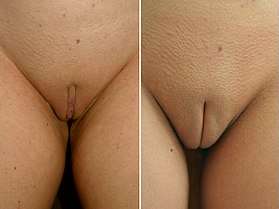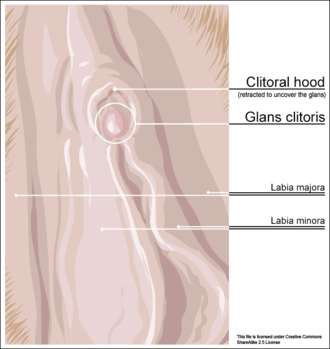Clitoral hood reduction
Clitoral hood reduction, also termed clitoral hoodectomy,[1] clitoral unhooding, clitoridotomy,[2][3] or (partial) hoodectomy, is a plastic surgery procedure for reducing the size and the area of the clitoral hood (prepuce) in order to further expose the clitoral glans of the clitoris.
| Clitoral hood reduction | |
|---|---|
 Plastic surgical reduction of the clitoral hood (prepuce) for aesthetic reasons. Left: before, right: after the surgery. | |
| Specialty | plastic surgeon |
It is sometimes done as a form of elective surgery where the therapeutic goals are to improve the sexual functioning of the patient and the aesthetic refinement of the vulva. It is a form of hoodplasty. The reduction of the clitoral prepuce tissues usually is a subordinate surgery within a labiaplasty procedure for reducing the labia minora, and occasionally within a vaginoplasty procedure. Patient surveys have indicated satisfaction with the outcome of such procedures. However, in 2007 the American College of Obstetricians and Gynecologists published an opinion advising against representing it as completely safe.
Surgical procedures

The procedures for labiaplasty occasionally include a clitoral hood reduction.[4] One technique for reducing the clitoral hood is the bilateral excision (cutting) of the prepuce tissues covering the clitoral glans, with especial attention to maintaining the glans in the midline.[5] Another technique cuts away (excises) the redundant folds of clitoral prepuce tissue, with incisions parallel to the long axis of the clitoris.[6]
Clitoral hood reduction can be included in the extended wedge resection labiaplasty technique, wherein the extension of the exterior wedge sections is applied to reducing the prepuce tissues of the clitoral glans. Yet, occasionally excess prepuce-skin, in the center of the clitoral hood, is removed with separate incisions.[7]
Results


Studies have reported a high rate of patient satisfaction with the aesthetic changes to the vulvo-vaginal complex after labioplasty, and a low incidence rate of medical complications.[5][7][8][9] The study Aesthetic Labia Minora and Clitoral Hood Reduction using Extended Central Wedge Resection (2008) reported that of a 407-woman cohort, 98 per cent were satisfied with the labial reduction outcomes; that the average patient satisfaction score was 9.2 points on a 10-point scale; that 95 per cent of the women experienced reduced pudendal discomfort; that 93 per cent of the women experienced improved self esteem; that 71 per cent experienced improved sexual functioning; that 0.6 per cent (one woman) reported lessened sexual functioning; and that 4.4 per cent of the women experienced medical complications.[7] The study Expectations and Experience of Labial Reduction: A Qualitative Study (2007) reported that the women who underwent labiaplasty had great expectations for the elimination of pubic discomfort and pain, improved cosmetic appearance of the vulva, and improved sexual functioning. Most of the women experienced improved self esteem; yet the study also reported that formal psychological counselling before the surgical operation about what to expect and what not to expect from a labia minora and clitoral prepuce reduction procedure might better serve the prospective patient by assisting her in establishing realistic expectations for her genital beauty and mental health after such a procedure.[10][11]
Criticism
Partial or total hoodectomy is classified by the World Health Organization as female genital mutilation (FGM) Type 1A.[12]
The American College of Obstetricians and Gynecologists (ACOG) published Committee Opinion No. 378: Vaginal "Rejuvenation" and Cosmetic Vaginal Procedures (2007), the college's formal policy statement of opposition to the commercial misrepresentations of labiaplasty, and associated vaginoplastic procedures, as medically "accepted and routine surgical practices". The ACOG doubts the medical safety and the therapeutic efficacy of the surgical techniques and procedures for performing vaginoplastic operations such as labiaplasty, vaginal rejuvenation, the designer vagina, revirgination, and G-spot amplification, and recommends that women seeking such genitoplastic surgeries must be fully informed, with the available surgical-safety statistics, of the potential health risks of surgical-wound infection, of pudendal nerve damage (resulting in either an insensitive or an over-sensitive vulva), of dyspareunia (painful coitus), of tissue adhesions (epidermoid cysts), and of painful scars.[13]
Risks
The dorsal nerves of the clitoris travel above the clitoris along the clitoral body. Permanent injury to these nerves can occur with clitoral hood reductions.[14]
References
- Renganathan, Arasee; Cartwright, Rufus; Cardozo, Linda (2009). "Gynecological cosmetic surgery". Expert Rev. Obstet. Gynecol. 4(2). Expert Review of Obstetrics & Gynecology. 4. p. 102. doi:10.1586/17474108.4.2.101.
The procedures described under female esthetic genital surgery are reduction labiaplasty, vaginaplasty, liposuction to mons pubis, fat injections to labia majora or mons, clitoral hoodectomy, hymenorrhaphy, 'G-spot amplification', and the use of a surgical laser in 'vaginal rejuvenation'.
(originally located at http://www.expert-reviews.com/doi/pdfplus/10.1586/17474108.4.2.101) - Carol Downer (1980). "Self-help for sex". Women's Sexual Development. Springer US. pp. 255–279.
Some therapists refer women for female circumcision (clitoridotomy) to have their clitoral hoods removed so that they can be more sensitive to the thrusts of the penis
- Maria Caterinala Barbera (2009). "Revisiting the anti-Female Genital Mutilation Discourse" (PDF).
Circumcision (also called clitoridotomy, τομία, Greek for “cut”, “incision”) is the mildest form of genital cutting. This involves the clitoral hood removal, but it preserves the clitoris and the posterior larger parts of the labia minora. In Islamic culture, circumcision is known as sunna (tradition), because it is mentioned in some ahadith (the sayings of the prophet Muhammad). This kind of cutting can be equated to male circumcision.
Cite journal requires|journal=(help) - Mirzabeigi MN, Moore JH Jr, Mericli AF, Bucciarelli P, Jandali S, Valerio IL, Stofman GM. Current Trends in Vaginal Labioplasty: A Survey of Plastic Surgeons. Annals of Plastic Surgery. 2011 PMID 21346521
- Felicio Y. Labial Surgery. Aesthetic Surgery Journal. 2007. 27:3;322–328.
- Hunter JG. Considerations in Female External Genital Aesthetic Surgery Techniques. Aesthetic Surgery Journal. 2008. 28:1;106–107.
- Alter GJ. Aesthetic Labia Minora and Clitoral Hood Reduction Using Extended Central Wedge Resection. Plastic and Reconstructive Surgery. 2008. 122:6; 1780–1789.
- Scholten E. Female Genital Cosmetic Surgery — The Future. Journal of Plastic, Reconstructive & Aesthetic Surgery. doi:10.1016/j.bps.2009.01.002.
- Mirzabeigi MN, Moore JH, Mericli AF, Bucciarelli P, Jandali S, Valerio IL, Stofman GM. Current Trends in Vaginal Labioplasty: A Survey of Plastic Surgeons. Annals of Plastic Surgery. 2011. PMID 21346521
- Bramwell R, Morland C, Garden AS. Expectations and Experience of Labial Reduction: A Qualitative Study. British Journal of Obstetrics and Gynaecology. 2007. 114(12);1493–1499.
- Di Saia JP. An Unusual Staged Labial Rejuvenation. Journal of Sexual Medicine. 2008:5;1263–1267.
- "Sexual and reproductive health: Classification of female genital mutilation". World Health Organization. Retrieved 2018-05-08.
- American College of Obstetricians and Gynecologists (2007). "Vaginal "Rejuvenation" and Cosmetic Vaginal Procedures" (PDF): 2. Archived from the original (PDF) on December 30, 2008. Cite journal requires
|journal=(help) - Ginger, Van Anh T.; Cold, Christopher J.; Yang, Claire C. (2011-02-04). "Surgical anatomy of the dorsal nerve of the clitoris". Neurourology and Urodynamics. 30 (3): 412–416. doi:10.1002/nau.20996. ISSN 0733-2467. PMID 21298720.